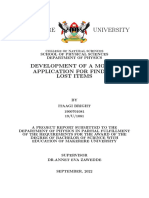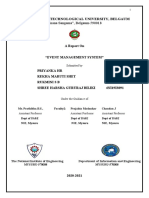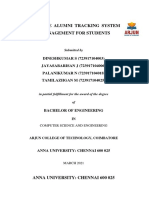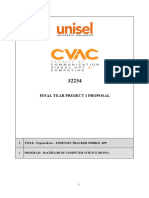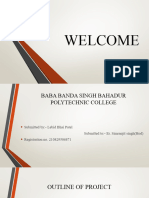LOST AND FOUND MANAGEMENT
SYSTEM
21CSC205P/DATABASE MANAGEMENT SYSTEM
PROJECT REPORT
Submitted by
METHUNRAJ A RA2311003050180
HARI RAMAN R RA2311003050215
THARANEESVAR A RA2311003050238
Under the guidance of
Dr. RAHMATH NISHA
(Assistant Professor, School of Computing)
in partial fulfilment for the award of the degree
of
BACHELOR OF TECHNOLOGY
in
COMPUTER SCIENCE AND ENGINEERING
Of
FACULTY OF ENGINEERING AND TECHNOLOGY
SRM INSTITUTE OF SCIENCE AND
TECHNOLOGY TIRUCHIRAPPALLI
1
� SRMINSTITUTEOFSCIENCEANDTECHNOLOGY
(Deemed to be University U/S3 of UGC Act,1956)
BONAFIDECERTIFICATE
Certified that this project report titled LOST AND FOUND MANAGEMENT
SYSTEM is the Bonafide work of METHUNRAJ A (RA2311003050180),
HARI RAMAN R (RA2311003050215), THARANEESVAR A
(RA2311003050238) who carried out the project work under my supervision.
Certified further, that to the best of my knowledge the work reported herein does
not form any other project report or dissertation on the basis of which a degree or
award was conferred on an occasion on this or any other candidate.
SIGNATURE SIGNATURE
Dr. RAHMATH NISHA,M.Tech.,Ph.D., Dr.KANAGA SUBA RAJA.S,M.E.,Ph.D.,
Assistant Professor
Head of the Department
School of Computing,
Department of COMPUTER SCIENCE
SRM Institute of Science and Technology,
AND ENGINEERING,
Tiruchirappalli.
SRM Institute of Science and Technology,
Tiruchirappalli.
Submitted for the project viva-voce held on 02.05.2025 at SRM Institute of Science and
Technology, Tiruchirappalli.
2
� SRM INSTITUTE OF SCIENCE AND
TECHNOLOGY
TIRUCHIRAPPALLI
DECLARATION
We hereby declare that the entire work contained in this project report titled
LOST AND FOUND MANAGEMENT SYSTEM has been carried out by
METHUNRAJ A(RA2311003050180),HARIRAMAN
R(RA2311003050215),THARANEESVAR A(RA2311003050238) at SRM
Institute of Science and Technology, Tiruchirappalli, under the guidance of
Dr.RAHMATH NISHA, Assistant Professor, School of Computing.
Place: Tiruchirappalli
Date:02.05.2025
3
� ABSTRACT
The Lost and Found Management System is a full-stack web application
designed to streamline the reporting and recovery of lost and found items. Built
using React (TypeScript, TailwindCSS) for the frontend and Flask for the
backend, it enables users to register, report items, upload images, and search
records efficiently. Improving accuracy beyond traditional text search.
The backend uses MySQL for data storage and provides secure RESTful APIs
for authentication, data handling, and image serving. File uploads are managed
through scalable custom endpoints. The modular architecture supports future
enhancements like notifications, chat, or cloud-based AI, making it suitable for
deployment in schools, public areas, or offices.
4
� TABLE OF CONTENTS
Page .no
ABSTARCT 4
LIST OF FIGURES 6
LIST OF ACRONYMS AND ABBREVIATIONS 7
1 Introduction 8
1.1 Introduction 8
1.2Problem Statement 8
1.3 Objectives 9
1.4 Scope and Motivation 9
2 Existing System 10
3 Design (ER Diagram) and Proposed Methodology 11
4 Implementation 16
5 Result and Discussion 17
6 Conclusion 19
7 References 20
5
� LIST OF FIGURES
3.1 Block Diagram 11
3.2 Flowchart 14
3.3 ER Diagram 15
5.1 Result 18
5.2 Output when the user logs in 18
5.3 Output when the user asks access 19
5.3 Output when the admin gives access 19
6
�LIST OF ACRONYMS AND ABBREVIATIONS
Acronym/
Full Form
Abbreviation
DB Database
Entity-Relationship
ER Diagram
Diagram
Role-Based Access
RBAC
Control
Mandatory Access
MAC
Control
Discretionary Access
DAC
Control
Amazon Web Services
AWS IAM Identity and Access
Management
National Institute of
NIST Standards and
Technology
Institute of Electrical
IEEE and Electronics
Engineers
International Business
IBM Machines Corporation
7
� CHAPTER 1
INTRODUCTION
1.1INTRODUCTION
In today’s fast-paced and interconnected world, the loss of personal belongings
in public spaces has become increasingly common. Traditional lost and found
systems, often manual and fragmented, fail to deliver satisfactory recovery rates
and user experience. This project presents a modern, AI-enhanced Lost and
Found Management System that provides an intuitive and structured approach
to reporting and retrieving misplaced items. Built with a full-stack architecture
involving React for the frontend, Flask for the backend, and MySQL for
database management, the system incorporates AI-powered image matching
using Siamese networks or convolutional neural networks (CNNs) to
significantly enhance item recognition and matching accuracy.
Users can register, report lost or found items, upload images, and receive
notifications. An admin panel ensures the authenticity of reports through a
verification process. The system also includes features such as location tagging,
time management, and status tracking to streamline the recovery process. By
focusing on efficient data handling and intelligent item correlation, this project
not only improves recovery outcomes but also serves as a learning platform that
demonstrates the power of AI integration in everyday problem-solving
scenarios.
1.2 PROBLEM STATEMENT:
In high-traffic public spaces such as schools, offices, and transportation hubs,
managing lost and found items is often inefficient and unreliable. Traditional
systems rely on manual processes or basic text logs, which are prone to human
error, slow matching, and low item recovery rates. These systems lack
intelligent mechanisms to identify similarities between lost and found items,
especially when users provide vague or incomplete descriptions.
There is a need for a lightweight, intelligent Lost and Found Management
System that automates item reporting, searching, and matching.
1.3 Objectives:
The main objective of this project is to design and implement a web-based Lost
and Found Management System that streamlines the process of reporting,
8
�searching, and recovering lost or found items using modern full-stack
technologies. The system aims to provide a responsive frontend built with React
(TypeScript, TailwindCSS) and a secure Flask-based backend, enabling users to
register, log in, report items, and perform intelligent searches.
A core feature of the system is the integration of an AI-powered image
matching algorithm based on a Siamese Neural Network, which enhances the
accuracy of matching items beyond traditional text-based search. Instead of
relying solely on keywords, the system uses visual similarity to identify
potential matches, helping users who cannot describe their items precisely.
Additionally, the platform includes efficient file upload handling,
structured MySQL database management, and modular APIs to support
scalability. The system also lays the groundwork for future extensions such as
real-time notifications, chat support, and cloud-based AI services. By combining
deep learning with web development, the project demonstrates a practical and
intelligent solution to common problems in lost and found operations.
1.4 SCOPE AND MOTIVATION:
This project aims to build a web-based Lost and Found Management
System using React for the frontend, Flask for the backend, and MySQL for
data storage. The scope includes user registration, item reporting, image
uploads, intelligent search, and AI-based image matching using a Siamese
Neural Network. The system also handles secure file management and scalable
API communication.
The motivation is to modernize the outdated manual lost and found
process by integrating AI and full-stack web development. It improves item
recovery accuracy and user experience while serving as a valuable learning tool
for students and developers exploring real-world applications of AI, databases,
and responsive design.
CHAPTER 2
9
� In most traditional environments, Lost and Found management is still
handled through manual or semi-digital methods, such as physical logbooks,
spreadsheets, or basic reporting tools. When someone loses or finds an item,
they must approach a designated office or staff member, fill out a form, and wait
for follow-up actions. This process is time-consuming, inconsistent, and often
leads to low item recovery rates.
There is typically no centralized database, and search functions are
rudimentary or completely absent. Users rely heavily on memory, vague textual
descriptions, and manual browsing through item logs. This significantly limits
the system's effectiveness—especially when there are many similar-looking
items or users cannot provide accurate details.
Another critical limitation is the lack of intelligent matching mechanisms.
Traditional systems do not use image recognition or AI to assist in identifying or
comparing lost and found items. As a result, matching is often based solely on
text, which can be ambiguous and subjective.
Additionally, file handling and image uploads are either unsupported or
poorly managed. Users may not be able to submit images easily, and even when
they do, there is no automated way to compare those images against existing
records.
Moreover, security and scalability are major concerns. Without proper
user authentication or structured backend support, the systems are vulnerable to
errors, misuse, and data loss. Manual entries are prone to mistakes, and tracking
item status becomes difficult as volume increases.
CHAPTER 3
10
� ER DIAGRAM AND PROPOSED METHODOLOGY
3.1 BLOCK DIAGRAM
Fig.3.1 block diagram
11
�1. Problem Definition
Identify the issue: Traditional lost and found processes are
manual, slow, and inaccurate.
Define system goals: Enable users to report, search, and retrieve
lost/found items efficiently.
Integrate AI-based image matching to improve item
identification accuracy.
2. Environment Modeling
Model the system as a web-based platform with:
Users (reporters, searchers)
Items (lost/found reports)
Database (storage for users, items, images, statuses)
Define data flow:
User → Form Submission → Backend → Database → AI
Matching → Output
3. User Interaction and Data Input
Users register/login using secure authentication.
Users report a lost/found item with:
Title, description, category
Location and time
Uploaded image
12
�4. Backend Processing
Flask API receives and validates requests.
Handles:
Data routing
File (image) storage
Status tracking
Saves item data into the MySQL database.
5. Matching Decision
If similarity threshold is met:
Notify the user about a potential match.
Display matched items for user confirmation.
If not:
Store the item for future matching.
6. Search and Retrieval
Users can manually search:
By item name, description, category, or location.
System provides filtered and sorted results.
Image preview helps with visual identification.
7. File Handling
13
� Image uploads are handled through a custom endpoint
(/uploads/<filename>).
Images are stored and served efficiently.
Scalable design for handling many files without performance
loss.
8. Conflict Handling (Duplicates / False Matches)
Track duplicate reports using:
Time stamps, image hashes, and location proximity.
Allow users to confirm/reject automated matches.
System learns from user responses to improve accuracy over
time.
9. Feedback & Future Optimization
Collect user feedback after item recovery.
Analyze matching success rate and user satisfaction.
Optimize:
AI model with more training data
Add real-time notifications
Integrate chat support or smart filters
Consider cloud deployment for scalability
14
�3.2 FLOWCHART
15
�3.3 ENTITY RELATIONSHIP DIAGRAM
Fig 3.3 ER Diagram
16
� CHAPTER 4
IMPLEMENTATION
4.1 IMPLEMENTATION
Front end
Itemdetails code
17
�18
�19
�20
�Login page code
21
�22
�Signup code
23
�24
�25
�Report code
26
�27
�BACKEND
App.py
28
�29
� CHAPTER 5
RESULTS AND DISCUSSION
5.1 RESULT:
Home page:
Signup page:
30
�Login page:
Main page:
31
�Report Page:
Item detail page:
32
� CHAPTER 6
CONCLUSION
In conclusion, the Lost and Found Management System addresses the
inefficiencies and limitations of traditional, manual lost item tracking
methods. Conventional approaches often suffer from low item recovery
rates, lack of automation, and poor user experience due to their reliance
on handwritten records or static databases. Our proposed system
revolutionizes this process by integrating AI-powered image matching, a
modern web interface, and a secure backend to streamline reporting,
matching, and retrieving lost and found items.
By automating the item matching process using a Siamese Neural
Network, the system greatly improves accuracy and reduces the
dependency on textual descriptions. The combination of a responsive
frontend (developed using React) and a Flask-based backend with a
MySQL database ensures data is processed, stored, and retrieved
efficiently. File uploads and image management are handled through
scalable API endpoints, supporting system growth over time.
Furthermore, the intuitive user interface simplifies reporting and
searching for users, while future-ready features such as notifications and
real-time filtering improve engagement and responsiveness. The
architecture is designed with extensibility in mind, allowing future
integration with cloud-based AI services or advanced user communication
tools.
Ultimately, this Lost and Found Management System delivers a
comprehensive, intelligent, and user-centric solution. It not only enhances
item recovery rates but also offers a scalable foundation for deployment
in environments such as schools, transportation hubs, workplaces, or
public venues. Through this innovation, we aim to create a more reliable,
efficient, and accessible system that benefits both users and
administrators.
33
� CHAPTER 7
REFERENCES
1. Bromley, J., Guyon, I., LeCun, Y., Säckinger, E., & Shah, R. (1993).
Signature Verification using a "Siamese" Time Delay Neural Network.
Advances in Neural Information Processing Systems (NeurIPS).
https://papers.nips.cc/paper_files/paper/1993/hash/afbfc3c3280072984e8
00db3cfdef498-Abstract.html
2. Krizhevsky, A., Sutskever, I., & Hinton, G. E. (2012).
ImageNet Classification with Deep Convolutional Neural Networks.
Advances in Neural Information Processing Systems.
https://papers.nips.cc/paper_files/paper/2012/file/c399862d3b9d6b76c84
36e924a68c45b-Paper.pdf
3. Zhang, D., Islam, M. M., & Lu, G. (2011).
A Review on Automatic Image Annotation Techniques.
Pattern Recognition Journal.
https://www.sciencedirect.com/science/article/abs/pii/S003132031100215
6
4. React Documentation — Building User Interfaces with ReactJS.
https://reactjs.org/
5. Flask Documentation — Flask Web Framework for Python.
https://flask.palletsprojects.com/
6. MySQL Documentation — Database Design and Management.
https://dev.mysql.com/doc/
7. Google Cloud AI Services — Vision API for Image Analysis.
https://cloud.google.com/vision
34







